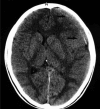Intracranial arachnoid cyst associated with traumatic intracystic hemorrhage and subdural haematoma
- PMID: 18923752
- PMCID: PMC2532960
Intracranial arachnoid cyst associated with traumatic intracystic hemorrhage and subdural haematoma
Abstract
Background: Brain arachnoid cysts are fluid collections of developmental origin. They are commonly detected incidentally in patients imaged for unrelated symptoms.
Case description: A 15-year-old healthy boy with a recent history of head trauma experienced headache that gradually worsened over the course of 10 days. He underwent CT and MRI brain scans which revealed the presence of subdural haematoma caused by the rupture of a middle cranial fossa arachnoid cyst. This was accompanied by intracystic haemorrhage. The subdural haematoma was removed, while communication of the cyst with the basal cisterns was also performed. The postoperative course of the patient was uneventful.
Conclusions: The annual haemorrhage risk for the patients with middle cranial fossa cysts remains very low. However, when haemorrhage occurs, in most occasions it can be effectively managed only with haematoma evacuation.
Keywords: intracranial arachnoid cyst; intracystic bleeding; subdural haematoma; treatment.
Figures



Similar articles
-
Spontaneous Subdural Hematoma and Intracystic Hemorrhage in an Arachnoid Cyst.Radiol Case Rep. 2015 Dec 7;4(3):298. doi: 10.2484/rcr.v4i3.298. eCollection 2009. Radiol Case Rep. 2015. PMID: 27307821 Free PMC article.
-
Spontaneous Rupture of a Parietal Arachnoid Cyst Causing an Intracystic Hemorrhage and a Subacute Subdural Hematoma.Cureus. 2024 Aug 20;16(8):e67280. doi: 10.7759/cureus.67280. eCollection 2024 Aug. Cureus. 2024. PMID: 39301329 Free PMC article.
-
Spontaneous Subdural Haematoma Developing Secondary to Arachnoid Cyst Rupture.J Clin Diagn Res. 2016 Oct;10(10):PD05-PD06. doi: 10.7860/JCDR/2016/21056.8708. Epub 2016 Oct 1. J Clin Diagn Res. 2016. PMID: 27891397 Free PMC article.
-
Spontaneous Intracystic Haemorrhage of an Arachnoid Cyst Associated with a Subacute Subdural Haematoma: A Case Report and Literature Review.Turk Neurosurg. 2019;29(6):940-944. doi: 10.5137/1019-5149.JTN.20885-17.2. Turk Neurosurg. 2019. PMID: 29091255 Review.
-
Intracranial aneurysm and arachnoid cyst: a rare association between two cerebral malformations.Br J Neurosurg. 2007 Aug;21(4):406-10. doi: 10.1080/02688690701466313. Br J Neurosurg. 2007. PMID: 17676464 Review.
Cited by
-
Spontaneous Subdural Hematoma and Intracystic Hemorrhage in an Arachnoid Cyst.Radiol Case Rep. 2015 Dec 7;4(3):298. doi: 10.2484/rcr.v4i3.298. eCollection 2009. Radiol Case Rep. 2015. PMID: 27307821 Free PMC article.
-
[Extra-axial brain tumors].Radiologe. 2012 Dec;52(12):1129-46. doi: 10.1007/s00117-012-2395-z. Radiologe. 2012. PMID: 23178788 Review. German.
-
Giant arachnoid cyst associated with acute subdural haematoma: A case report.Neuroradiol J. 2017 Jun;30(3):286-289. doi: 10.1177/1971400917697731. Epub 2017 Apr 4. Neuroradiol J. 2017. PMID: 28374621 Free PMC article.
-
Arachnoid Cysts in Athletes with Sports-Related Concussion: A Case Series and Literature Review.Sports Med Open. 2024 Sep 2;10(1):93. doi: 10.1186/s40798-024-00757-x. Sports Med Open. 2024. PMID: 39222159 Free PMC article.
-
Ruptured Sylvian arachnoid cysts: an update on a real problem.Childs Nerv Syst. 2023 Jan;39(1):93-119. doi: 10.1007/s00381-022-05685-3. Epub 2022 Sep 28. Childs Nerv Syst. 2023. PMID: 36169701 Free PMC article. Review.
References
-
- Iaconetta G, Esposito M, Maiuri F, Cappabianca P. Arachnoid cyst with intracystic haemorrhage and subdural haematoma: case report and literature review. Neurol Sci. 2006;26:451–455. - PubMed
-
- Gosalakkal JA. Intracranial arachnoid cysts in children: a review of pathogenesis, clinical features and management. Pediatr Neurol. 2002;26:93–98. - PubMed
-
- Hopkin J, Mamourian A, Lollis S, Duhaime T. The next extreme sport? Subdural haematoma in a patient with arachnoid cyst after head shaking competition. Br J Neurosurg. 2006;20:111–113. - PubMed
-
- Parsch CS, Krauss J, Hofmann E, Meixensberger J, Roosen K. Arachnoid cysts associated with subdural hematomas and hygromas: analysis of 16 cases, long-term follow-up and review of the literature. Neurosurgery. 1997;40:483–490. - PubMed
-
- Kanev PM. Chapter208, Arachnoid cyst. In: Youmans JR, editor. Neurological Surgery. ed 3. vol 3. Philadelphia: Saunders; 2004. pp. 3289–3299.
Publication types
LinkOut - more resources
Full Text Sources
